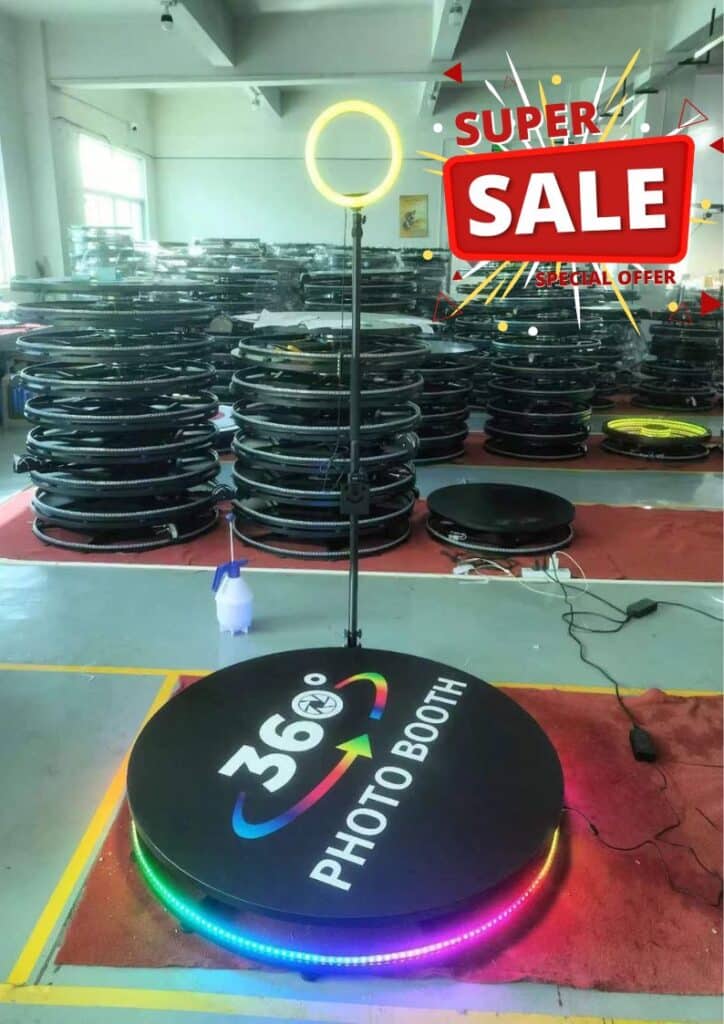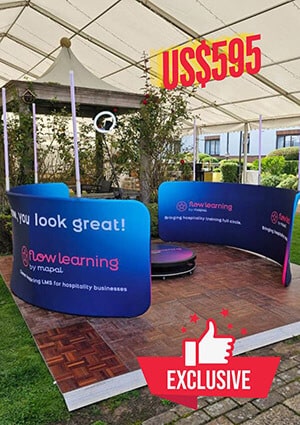Table of Contents
Introduction
Setting up a 360 video booth can seem daunting, especially if you’re aiming for a quick and efficient setup. However, with the right strategies and preparation, you can streamline the process and ensure everything runs smoothly. Whether you’re an event planner, DJ, or entertainment business owner, these tips will help you get your 360 video booth up and running in no time.
Understanding Your 360 Video Booth
Before diving into setup tips, it’s essential to understand the components of your 360 video booth. Typically, a 360 video booth consists of:
- Camera: Usually a smartphone, GoPro, or DSLR camera mounted on an adjustable arm.
- Rotating Platform: Where guests stand, pose, or dance.
- Lighting: Ensures proper illumination for high-quality video.
- Software: Processes and edits the captured video.
Knowing how each part functions will make the setup process more straightforward and efficient.
Tip 1: Preparation is Key
Preparation is crucial for a fast setup.
Start by planning your 360 spin setup in advance.
Know the layout of the venue and the space available for your booth. Conduct pre-event checks to ensure all equipment is functioning correctly.
Pack your gear systematically, so you know where everything is when you arrive at the venue.
Tip 2: Choosing the Right Location
Location plays a significant role in the effectiveness of your 360 video booth.
Choose a spot with ample space for the rotating platform and enough room for guests to move comfortably.
Consider the 360 booth enclosure and lighting of the location. Avoid areas with high foot traffic to prevent interruptions.
Tip 3: Assembling the 360 Booth Efficiently
To assemble your booth efficiently, follow these steps:
- Set up the rotating platform: Ensure it is stable and secure.
- Mount the camera on the arm: Adjust the arm for optimal height and angle.
- Arrange the lighting: Position lights to eliminate shadows and provide even illumination.
- Connect the software: Ensure your camera and software are synced for seamless operation.
Avoid common mistakes like improper alignment of the camera or unstable platform setup.
Tip 4: Ensuring Proper Lighting
Lighting can make or break the quality of your 360 Video Booth.
Use softbox lights or ring lights for even and flattering illumination.
Position lights to minimize shadows and highlight your subjects from multiple angles.
Experiment with different lighting setups during your pre-event checks to find the best configuration.
Tip 5: Testing Before the Event
Testing your setup before the event is vital. Run a few test videos to check for any issues with lighting, camera angles, or software integration. Troubleshoot any problems immediately. This step ensures you’re prepared and reduces the likelihood of technical difficulties during the event.
Maintaining Your 360 Video Booth
Regular maintenance of your 360 video booth ensures its longevity and reliability.
Clean the camera lens and rotating platform regularly. Check all connections and cables for wear and tear.
Store your equipment properly to prevent damage when not in use.
Software Setup and Integration
Choosing the right software for your 360 video booth is crucial. Look for software that offers easy integration with your camera and provides robust editing features. Popular options include Touchpix and other 360 video booth software. Ensure your software is updated and tested before the event.
Engaging with Guests
Interacting with guests enhances their experience with your 360 video booth. Encourage them to be creative with their poses and movements. Provide props and backdrops to make the experience more fun and memorable. Guide them on how to use the booth for the best results.
Customizing Your 360 Video Booth
Personalization can make your 360 video booth stand out. Offer custom backdrops, branded overlays, and unique props. Tailor the experience to match the theme of the event. Personalization not only enhances the user experience but also makes your booth more attractive to potential clients.
Marketing Your 360 Video Booth Services
Effective marketing is key to attracting clients. Utilize social media platforms to showcase your 360 video booth in action. Share videos from past events and highlight unique features. Collaborate with event planners and influencers to reach a wider audience. Offering special promotions can also drive interest.
Safety Considerations
Safety should always be a priority when setting up and operating your 360 video booth.
Ensure the rotating platform is stable and secure. Use cables and connections that meet safety standards.
Manage crowd control around the booth to prevent accidents and ensure a smooth operation.
Troubleshooting On-site Issues
Being prepared for on-site issues can save your event. Keep spare parts and backup equipment handy. Familiarize yourself with common problems like software glitches or camera malfunctions and their solutions. Having a troubleshooting plan ensures you can handle issues quickly and efficiently.
Conclusion
Setting up a 360 video booth quickly and efficiently is achievable with proper preparation and the right strategies.
By understanding your equipment, planning ahead, and being prepared for any issues, you can ensure a smooth setup and an enjoyable experience for your guests. Implement these tips, and you’ll be well on your way to mastering the art of the 360 video booth setup.
FAQs
How long does it take to set up a 360 video booth?
The setup time can vary, but with proper preparation, it typically takes about 30 minutes to an hour.
What are the essential components needed for setup?
Key components include the rotating platform, camera, lighting, and software for processing videos.
How can I ensure the best lighting for my booth?
Use softbox lights or ring lights positioned to minimize shadows and provide even illumination.
What should I do if my booth malfunctions during an event?
Have a troubleshooting plan in place, keep spare parts handy, and be familiar with common issues and their solutions.
How can I make my 360 video booth stand out?
Customize your booth with unique backdrops, branded overlays, and props. Use social media to showcase your work and attract more clients.


